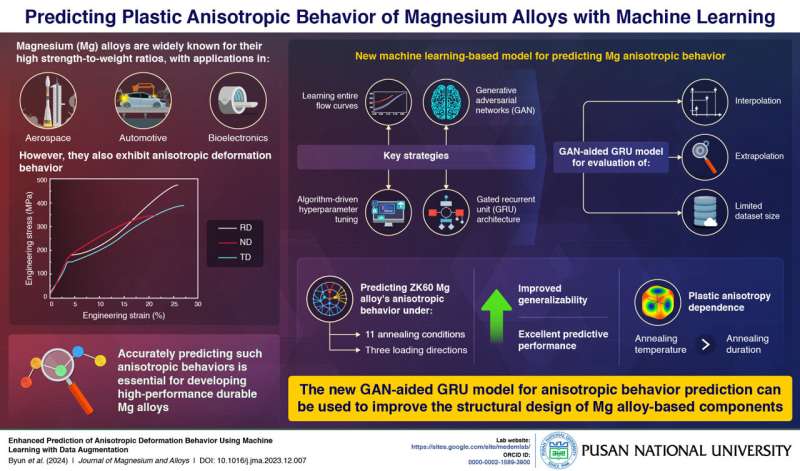This article has been reviewed according to Science X's editorial process and policies. Editors have highlighted the following attributes while ensuring the content's credibility:
fact-checked
trusted source
proofread
Researchers employ artificial intelligence to unlock the secrets of magnesium alloy anisotropy

Magnesium (Mg) alloys have been popularly used for designing aerospace and automotive parts owing to their high strength-to-weight ratio. Their biocompatibility and low density also make these alloys ideal for use in biomedical and electronic equipment. However, Mg alloys are known to exhibit plastic anisotropic behavior. In other words, their mechanical properties vary depending on the direction of the applied load.
To ensure that the performance of these Mg alloys is unaffected by this anisotropic behavior, a better understanding of the anisotropic deformations and the development of models for their analysis is needed.
According to Metal Design & Manufacturing (MEDEM) Lab led by Associate Professor Taekyung Lee from Pusan National University, Republic of Korea, machine learning (ML) might hold answers to this prediction problem. In their recent breakthrough, the team proposed a novel approach called "Generative adversarial networks (GAN)-aided gated recurrent unit (GRU)."
The model holds powerful data analysis abilities to accurately predict the plastic anisotropic properties of wrought Mg alloys. Their work was made available online in the Journal of Magnesium and Alloys on 16 January 2024.
"In terms of the accuracy of ML predictions from the viewpoint of data science, we realized that there was room for improvement. So, unlike the previously reported methods of prediction, we developed an ML model with data augmentation to attain accuracy, as well as generalizability with respect to various loading modes," says Prof. Lee, describing the core idea behind their novel model.
"This eventually opened ways of integration with a finite-element analysis to extract precise stress estimation of products made from metal alloys with significant plastic anisotropy."
To build a model with enhanced accuracy, the team combined the entire flow curves, GAN, algorithm-driven hyperparameter tuning, and GRU architecture, which are some of the key strategies used in data science. This new approach facilitates the learning of entire flow-curve data rather than being limited to train on summarized mechanical properties, like many previous models.
To test the reliability of the GAN-aided GRU model, the team extensively evaluated it under predictive scenarios, ranging from extrapolation, interpolation, and robustness, with datasets of limited size. When put to the test, the model estimated the anisotropic behavior of ZK60 Mg alloys for three loading directions and under 11 annealing conditions.
With these experiments, the team discovered that their model showed significantly better robustness and generalizability than other models designed to perform similar tasks. This superior performance is mainly attributed to GAN-aided data augmentation and supported by the excellent extrapolation ability of GRU architecture and optimization of hyperparameters—parameters whose values are used to control the learning process.
Therefore, this study takes predictive modeling beyond artificial neural networks. It successfully demonstrates the ability of ML-based models for estimating the anisotropic deformation behaviors of wrought Mg alloys.
"The overall performance and lifespan of components made from Mg alloy are largely dependent on the plastic anisotropic behavior which makes forecasting and management of deformations a vital part of material design. We believe that the model will assist in the design and manufacturing of metal products for various applications," concludes Prof. Lee.
More information: Sujeong Byun et al, Enhanced prediction of anisotropic deformation behavior using machine learning with data augmentation, Journal of Magnesium and Alloys (2024). DOI: 10.1016/j.jma.2023.12.007
Provided by Pusan National University





















